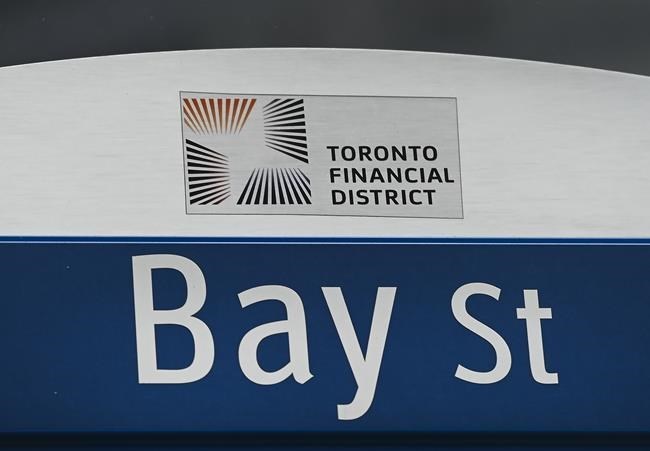TORONTO — Canada's main stock index rose for a fifth straight day to end its best week in 10 months as optimism continued to fuel gains despite disappointing jobs numbers.
The S&P/TSX composite index gained 93.93 points to post a record close of 18,135.90 after setting another intraday high of 18,159.20. The Toronto market gained 4.6 per cent for the week, its best performance since April.
U.S. markets were also strong with the S&;P 500 and the Nasdaq composite again setting record closes and intraday highs.
In New York, the Dow Jones industrial average was up 92.38 points at 31,148.24. The S&P 500 index was up 15.09 points at 3,886.83, while the Nasdaq composite was up 78.56 points at 13,856.30.
Investors were buoyed by oncoming additional fiscal stimulus out of the United States and positive fourth-quarter earnings with about 60 per cent of U.S. companies reporting so far, says Philip Petursson, chief investment strategist at Manulife Investment Management.
"We would say that the earnings recovery has started and it leads to optimism over the course of 2021 that earnings expectations can not only be met but greatly surpassed," he said in an interview.
Despite political disagreements in Congress, Vice-President Kamala Harris broke a tie early Friday morning to give Senate approval to a budget resolution for a US$1.9-trillion stimulus package.
It's debatable whether that amount of stimulus is actually needed at this time, but the Biden administration is being pre-emptive to address any potential economic weaknesses, said Petursson.
"From the market perspective, this is just more fuel to the rally and it's going to create what we think could be just a very, very strong push in terms of economic momentum in the back half of 2021."
Petursson said concern about inflation anxiety is missing at the current time with many investors discounting the sustainability of higher inflation and what that could do to higher bond yields.
"There is a potential for overheating but I don't think that anyone (the Federal Reserve and the U.S. government) ... seem to be overly concerned," he said.
"It's almost like it would be a good problem to have but that might be more of a 2022 story as opposed to 2021."
Friday's market strength came despite disappointing jobs numbers in Canada and the U.S.
Canada's labour market saw months of gains wiped out in a matter of weeks as widespread lockdowns and school closures erased 212,800 jobs in January and the unemployment rate increased by 0.6 percentage points to 9.4 per cent, the highest rate since August.
U.S. employers added just 49,000 positions in a tepid rebound after 227,000 jobs were lost in December. Still, the unemployment rate fell sharply in January to 6.3 from 6.7 per cent, in part because it excluded people who stopped looking for work.
That data is backward looking and reflects the impact of renewed lockdowns, said Petursson.
"So you can look right past that data through to the back half of 2021 or even to the second quarter of 2021 and see a quickly, rapidly improving environment."
Materials and energy led the TSX higher in a broad-based rally involving eight of the 11 major sectors.
Materials gained 1.9 per cent on increased gold prices with Eldorado Gold and New Gold Inc. up 12 and 6.3 per cent, respectively.
The April gold contract was up US$21.80 at US$1,813.00 an ounce and the March copper contract was up 7.3 cents at nearly US$3.63 a pound.
The energy sector rose as crude oil prices hit their higher level since January 2020 with Seven Generations Energy Ltd. up 5.7 per cent.
The March crude oil contract was up 62 cents at US$56.85 per barrel after hitting a high of US$57.29. The March natural gas contract was down 7.2 cents at US$2.86 per mmBTU.
"Oil prices have surprised us in how quickly they can break above $50 and stay there," said Petursson, adding Manulife has boosted its target to US$65 a barrel in 2021.
"Over the course of the year I think energy is going to be one of the drivers of the TSX performance."
The Canadian dollar traded for 78.28 cents US compared with 77.95 cents US on Thursday.
BlackBerry Ltd gained 8.3 per cent to push technology up 1.1 per cent.
While its premature to say whether markets will defy the negative historical trend for February, Petursson is optimistic.
"I think we've gotten past some of the volatility of January. We know the economic data is only going to get better, not weaker, and so I think that sets up for — fingers crossed — a better than expected February."
This report by The Canadian Press was first published Feb. 5, 2021.
Companies in this story: (TSX:ELD, TSX:NGD, TSX:BB, TSX:VII, TSX:GSPTSE, TSX:CADUSD=X)
Ross Marowits, The Canadian Press



